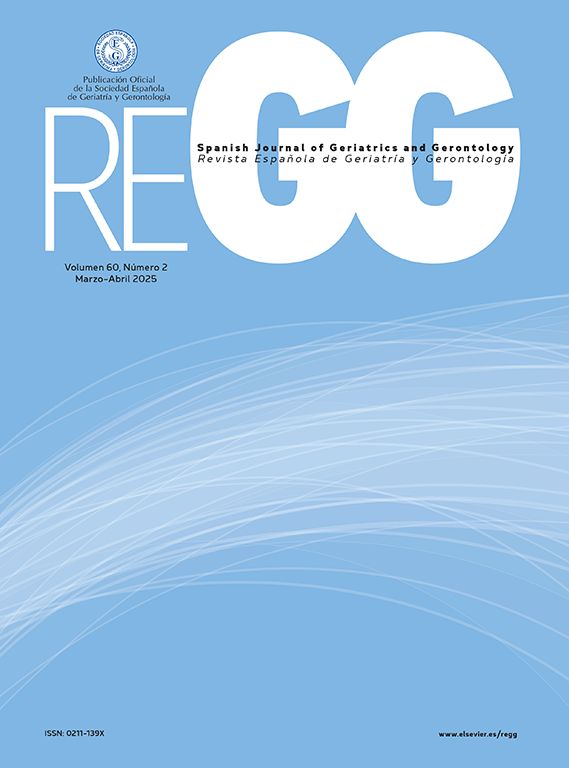El objetivo de este estudio ha sido determinar los factores asociados, en relación con la evolución mortal, de las bacteriemias-fungemias ocurridas en un año, y comparar los resultados en la población con edades comprendidas entre 60 y 70 años y la población mayor de 70 años.
Pacientes Y MetodosEstudio descriptivo, prospectivo de todos los episodios de bacteriemias-fungemias producidos en el Hospital Universitario de la Princesa de Madrid, entre el 16 de mayo de1996 y el 14 de mayo de1997. Se utilizaron las mismas definiciones en los dos grupos de estudio. El análisis univariado de los resultados se realizó con el test de la χ2 y las variables con más de dos categorías mediante regresión logística, considerándose significación estadística un valor de p < 0,05.
ResultadosUn total de 250 episodios han sido analizados, 158 en personas mayores de 70 años frente a 92 episodios en el grupo de pacientes con edades comprendidas entre 60 y 70 años. Globalmente, no existe diferencia en cuanto a la mortalidad en ambos grupos (odds ratio [OR] = 1,22; intervalo, 0,66-2,24). El servicio que más episodios recibe en ambos grupos es el médico. Los microorganismos más frecuentes asociados a bacteriemia son los gramnegativos. La adquisición extrahospitalaria es la más habitual. El origen más frecuente es el vascular en el grupo de 60-70 años, y el genitourinario en el grupo de los mayores de 70 años. Hay un alto porcentaje de tratamientos quirúrgicos adecuados en ambos grupos. Las variables con significación clínica y estadística en cuanto a la evolución mortal en el grupo de 60-70 años son: adquisición intrahospitalaria (OR = 6,28 [1,9-20,7]); hipotensión(OR = 4,46 [1,14-17,4]); coagulacion intravascular diseminada (OR = 4,93 [3,14-7,75]). Sin embargo, se asocia a menor evolucion mortal la realizacion de un tratamiento quirurgico adecuado (OR = 10,76 [2,017-57,05]). En el grupo de mas de 70 anos son factores asociados a mal pronostico en cuanto a evolucion a muerte: uso previo de antibioticos (OR = 2,71 [1,25-6,13]); hipotension (OR = 3,35 [1,34-8,36]); trombopenia (OR = 2,7 [0,97-7,69]); coagulación intravascular diseminada (OR = 7,51 [0,65-83]). Sin embargo, también el tratamiento quirúrgico adecuado es un factor asociado a mejor pronóstico (OR = 6,03 [1,62-22,35]).
ConclusionesNo existen diferencias en cuanto a mortalidad en las personas con edades comprendidas entre 60 y 70 años y en los mayores de 70 años. Muchas de las variables se mantienen constantes en ambos grupos, lo que indica la potencia de dichas variables independientemente de la edad, siendo llamativa la asociación a mejor pronóstico del tratamiento quirúrgico adecuado, lo que debe favorecer dicho tipo de intervención terapéutica en caso necesario, independientemente de la edad.
The aim of this study was to analyze the factors associated with death from bacteraemias and fungemias over a 1-year period and to compare the results in individuals aged 60-70 years old with those in individuals aged more than 70 years.
Patients and MethodsWe performed a prospective, descriptive study of all episodes of bacteraemias-fungemias in the Princesa de Madrid University Hospital between 16/5/1996 and 14/5/1997. The same definitions were used in both study groups. Univariate analysis was performed with the Chi-square test and variables with more than two categories were analyzed using logistic regression. Values of p < 0.05 were considered statistically significant.
ResultsA total of 250 episodes were analyzed. There were 158 episodes in individuals aged more than 70 years and 92 episodes in the group of patients aged 60-70 years. Overall, there was no difference in mortality between the two groups: OR 1.22 (0.66-2.24). The department with the greatest number of episodes of bacteraemia in both groups was the medical department. The microorganisms most frequently associated with bacteraemia were Gram-negative. Extrahospital acquisition was more frequent than intrahospital acquisition. The most frequent origins were vascular procedures in the group aged 60-70 years and genitourinary procedures in the group aged more than 70 years. Appropriate surgi- cal treatment was frequent in both groups. The clinically and statistically significant variables associated with mortality in the group aged 60-70 years were: intrahospital acquisition [OR 6.28 (1.9-20.7)], hypotension [OR 4.46 (1.14-17.4)], and disseminated intravascular coagulation [OR 4.93 (3.14-7.75)]. However, lower mortality was associated with appropriate surgical treatment [OR 10.76 (2.017-57.05)]. In the group aged more than 70 years, the factors associated with mortality were: prior use of antibiotics [OR 2.71 (1.25-6.13)], hypotension [OR 3.35 (1.34- 8.36)], thrombopenia [OR 2.7 (0.97-7.69)], and disseminated intravascular coagulation [OR 7.51 (0.65-83)]. However, appropriate surgical treatment was also associated with improved prognosis in this group [OR 6.03 (1.62-22.35)].
ConclusionsNo differences were found in mortality between patients aged 60-70 years and those aged more than 70 years. Many of the variables were similar in both groups. Notable was the association between improved prognosis and appropriate surgical treatment, which should encourage the use of this type of intervention, when required, independent of age.






